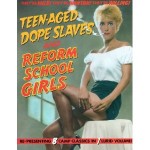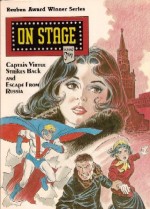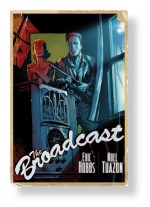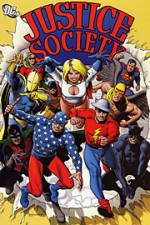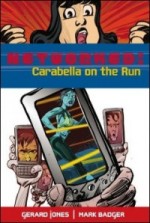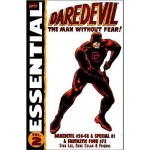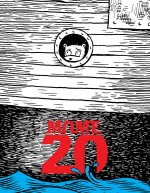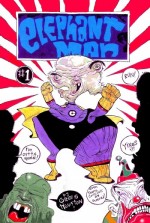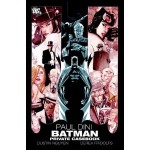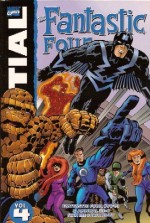
By Stan Lee, Jack Kirby, Joe Sinnott & various (Marvel)
ISBN: 978-0-7851-1484-X
This fabulous fourth black-and-white compendium of the classic and landmark “Stan & Jack†Fantastic Four sees the feature achieve its highest potential in a string of superlative tales that proved the bold boast on every cover… “World’s Greatest Comic Magazine!â€
Jack Kirby was in his conceptual prime and continually unleashed his vast imagination on spectacular plot after plot whilst Stan Lee scripted some of the most passionate superhero sagas that Marvel – or any publisher, for that matter – has ever seen. Both were on an unstoppable roll, at the height of their creative powers, and full of the confidence that only success brings, with Kirby in particular eager to see how far the genre and the medium could be pushed.
This volume, covering the early career of comics’ First Family covers Fantastic Four #64-83 (July 1967-February 1969) plus the fifth and sixth annuals, a bombastic blend of super-science, soap opera and stunning action that has seldom been equaled and never bettered.
The magic commences with ‘The Sentry Sinister’ (inked as always by Joe Sinnott) a frenetic adventure romp which pitted the team against a super-scientific robot buried for millennia by an ancient star-faring race. This tropical treat expanded the burgeoning interlocking landscape to an infinite degree by introducing the imperial Kree who would grow into one of the fundamental pillars supporting the continuity of the Marvel Universe.
Although regarded as long-dead the Kree themselves resurfaced in the very next issue as the team was attacked by an alien emissary ‘…From Beyond this Planet Earth!’ The formidable Ronan the Accuser turned up looking to see what could possibly have destroyed his Sentry. Simultaneously The Thing’s blind girlfriend Alicia was abducted by a super scientific stranger…
The mystery of her disappearance was revealed in #66 in ‘What Lurks Behind the Beehive?’ as the heroes trailed the seemingly helpless girl to a technological wonderland where a band of rogue geniuses had genetically engineered the next phase in evolution but lost control of it even before it could be properly born…
‘When Opens the Cocoon!’ revealed the secret of the creature known only as Him and only Alicia’s gentle nature could placate the nigh-omnipotent creature (who would eventually evolve into the tragic cosmic voyager Adam Warlock), after which the tight continuity gradually paused to allow the Inhumans (a time-lost race of paranormal beings long secluded from mortal men) and the Black Panther to share the stage in that year’s Annual, wherein the sinister invader Psycho-Man attempted to ‘Divide… and Conquer!’
Frank Giacoia actually inked this wrongly attributed yarn that pitted the emotion-bending invader against both the King of Wakanda and the Royal Family of hidden Attilan until the FF could pitch in, delayed as they were by the news that the Sue Richards was pregnant – and soon to confined in the most appallingly sexist manner until the birth…
The Annual also included another comedy insight into the creation of Marvel Epics as Stan, Jack and Frank asked ‘This is a Plot?’ and after the now customary Kirby pin-ups (Inhumans Black Bolt, Gorgon, Medusa, Karnak, Triton, Crystal and Maximus, a colossal group shot of Galactus the Silver Surfer and others and a double page spread of the FF themselves) a rapidly rising star-in-the-making got his first solo appearance in ‘The Peerless Power of the Silver Surfer’ a pithy fable of cruel ingratitude that reintroduced the Mad Thinker’s lethal Artificial Intelligence creation Quasimodo…
In FF #68 the Thinker himself enacted his latest plan and ‘His Mission: Destroy the Fantastic Four!’ as the cogitating criminal replaced a famous doctor and subverted a potential cure for The Thing’s rocky condition into a mind-warping scheme to turn the Thing against his comrades (inked as ever by the remarkable Joe Sinnott). The scheme progressed in ‘By Ben Betrayed!’ as the newly malevolent Grimm attempted to murder the rest of the team only to be driven temporarily away. Desperately searching for him the FF soon captured the Thinker and freed Ben from mind-control in ‘When Fall the Mighty!’ but the victory left the heroes unconscious and only Sue conscious to tackle the villains last-ditch killer android in ‘…And So It Ends…’
With baby on board Reed and Sue resigned, leaving Ben, Johnny and the Inhuman maid Crystal to hold the fort when cosmic calamity came calling. In ‘Where Soars the Silver Surfer!’ the sky-born wanderer imprisoned on Earth by the world-devouring Galactus went cage-crazy and attacked humanity, forcing Reed’s return, whilst #73 presented the conclusion to a long-running Daredevil (see Essential Daredevil volume 2) story wherein the sightless crusader was ousted from his own body by the Iron Dictator Doctor Doom.
Warning the FF of imminent attack the Man without Fear then subsequently defeated Doom – but neglected to tell the heroes of his victory… outmatched and unable to convince them any other way DD enlisted Thor and Spider-Man in ‘The Flames of Battle…’ to solve the problem Marvel style – with a spectacular pointless and utterly riveting punch-up…
The Surfer was back in #74 ‘When Calls Galactus’ as the planet-eater returned to our skies demanding that his one-time herald once more become his food-finding slave, but despite his increasingly violent probings, Galactus cannot locate his target. That’s because the Surfer had departed for ‘World Within Worlds!’ forcing Reed, Ben and Johnny to follow. When attacked by Psycho Man they are ‘Stranded in Sub-Atomica!’ and as they struggle to survive Galactus applies ever-more pressure… ‘Shall Earth Endure?’
Turning himself in to save Earth, the Surfer is summarily returned to his captivity here as soon as ungrateful Galactus is finished feeding, just in time to begin his own landmark series – but that’s the subject of another review, another time…
Meanwhile in FF#78 another attempt to cure Ben Grimm goes awry in ‘The Thing No More!’ due to interference from old foe The Wizard and, in ‘A Monster Forever?’, Ben’s choice to stay a rocky monster and save his friends from the bludgeoning Android Man.
A brief change of pace took the team to the Indian Lands of old friend Wyatt Wingfoot to solve an eerie mystery ‘Where Treads the Living Totem!‘ before the sixth Annual spotlighted the birth of Franklin Richards. Unfortunately however, not before Reed, Ben and Johnny invaded the anti-matter Negative Zone to confront a monstrous creature named Annihilus whose power was the only thing that could prevent the death of Sue and her unborn child. ‘Let There Be… Life!’ is a groundbreaking 48 page epic that is as stunning to read now as it ever was, passionate thrilling and mind-boggling in its visual intensity.
With Sue a new mother faithful Crystal became the first new official member of the team and promptly showed her mettle by pulverizing the incorrigible Wizard in #81’s ‘Enter… the Exquisite Elemental!’ and this volume concludes with a classic two-part clash against the inhuman Maximus as he once more attempted to conquer mortal humanity. ‘The Mark of… the Madman!’ saw the FF come to the aid of the imprisoned Royal Family of Attilan before together trouncing the insane despot in ‘Shall Man Survive?’
Did I say concludes? Not quite as this book still finds room for a selection of 6 original art pages from Kirby and his alternate cover for issue #65, you lucky, lucky people…
These are the stories that confirmed Jack Kirby as the absolute master of superhero storytelling and gave Marvel the push needed to overtake the decades-dominant DC. They’re also some of the very best comics ever produced and as thrilling and compulsive now as they ever were. This is a must-have book for all fans of graphic narrative.
© 1967, 1968, 1969, 2005 Marvel Characters, Inc. All Rights Reserved.

